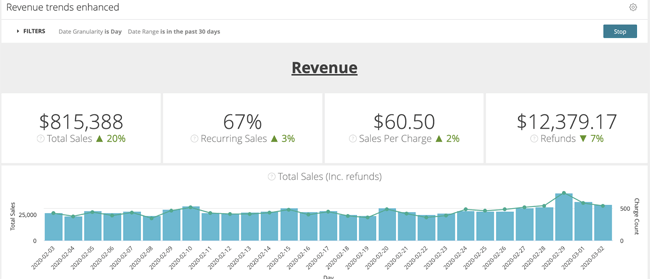You’ve built a stunning eCommerce platform with Shopify, but you’re seeing that your clients aren’t returning after one or two transactions. They suit your target audience, seem to like your goods, and even leave positive feedback. How do you turn infrequent shoppers into repeat customers? This is where the ReCharge Shopify partnership can come in handy. Learn how ReCharge operates with Shopify and how you can take advantage of its features behind the scenes, during the customer’s buying journey, and after a purchase.
What Is ReCharge?
Recharge is a Shopify app that adds membership features and monthly billing to your online store. This subscription-based model is ideal for assisting stores in upscaling and development.
The ReCharge connection from Littledata is an automatic data connector for Shopify and Shopify Plus stores that use ReCharge to power their subscription e-commerce. When activated, it unifies data in the background by using Shopify and ReCharge webhooks. Littledata connects the Shopify account, marketing networks, and Google Analytics in real-time. This allows connections with websites and applications such as Segment, ReCharge, CartHook, Facebook Ads, and Google Ads.
ReCharge assists retailers with this by enabling them to set up subscriptions for the goods in their shop, thus increasing their chances of retaining buyers. It’s designed to make things as simple as possible for both the retailer and the customer by putting all the details on key Shopify store pages.
ReCharge, Shopify, and Their Relationship
ReCharge’s area of expertise is annual billing. This easy addition to your online shop can be extremely lucrative. You can quickly offer your customers the opportunity to subscribe to your shop thanks to ReCharge’s simple incorporation through Shopify’s established framework. This reduces turnover, increases customer satisfaction, and improves the bottom line.
According to a McKinsey & Company report, with over 15% of online customers signing up for subscriptions and the subscription e-commerce industry rising by 100% year after year, offering this as a choice for customers is critical.
So how does recurring billing do this? Simply stated, the method of making a one-time transaction is surprisingly inefficient. When a customer attaches a product to their cart, they must complete the checkout process by entering all of their payment and shipping information. However, after they’ve bought the items, all of their payment information is erased. To repurchase these same items or other products in the future, they must go through the whole checkout phase again.
Making periodic subscriptions easy with the ReCharge app solves this challenge while increasing customer satisfaction and sales. Customers’ payment details and order preferences are safely saved on ReCharge’s third-party platform until they complete the checkout process on your Shopify store. Following that, repeat orders are automatically processed, converting shoppers into customers and turnover into recurring sales.
When you integrate ReCharge into your Shopify store, you get more than just recurring billing options. It also opens up new possibilities for back-end customization and an improved customer interface.
The Shopping Experience at ReCharge
Once you’ve created the perfect platform for repeat purchases, you can concentrate on the real-time shopping experience. Here are some of the ways ReCharge contributes to the consumer experience, from the moment they visit your website to the moment they check out.
Customers that make a regular order from your Shopify store are guided to ReCharge’s consumer portal. Safe and directly connected to your Shopify store, this portal can be personalized to match your brand’s aesthetic.
This is simple to accomplish thanks to the highly adaptable ReCharge Theme Engine. It allows you to easily customize the UI settings, positioning, and animations to match your company’s current style while also providing a smooth shopping experience.
A recurrent order’s checkout mechanism is distinct from Shopify’s default checkout tab. With these instructions, the consumer is guided to ReCharge’s safe checkout. Before proceeding, they will be asked to build an account on the website. While it is a different website, you can also use CSS to change its appearance to match the rest of your online store. This way, you can keep your shopping experience consistent and easy throughout.
The ReCharge add-on also includes cancellation prevention. Unsure shoppers who click out of their cart are prompted with offers and questions before leaving. You have complete control of these flows and should ensure these communications are consistent with the brand.
ReCharge After Purchase Works for Customer Retention
When a customer completes a transaction, the job does not cease. And if a monthly order retains customers longer than a one-time buy, you should do more to keep them interested. ReCharge not only provides you with customizability and power over your shop’s back-end growth, but it also prioritizes versatility. This enables you to provide your clients with the choices they require to leave satisfied and, most importantly, to return happier.
Workflow Automation
ReCharge has automatic workflows that enable you to deliver personalized prompts to customers based on their subscription background. Although analytics isn’t specifically integrated into the software, ReCharge interacts with several Shopify-approved analytics tools, which will notify the automated workflows for improved consumer interaction.
Management of Subscriptions
The ReCharge app add-on does more than just create repeat orders. It also allows customers to conveniently monitor their subscriptions through the customer portal. This continues the positive customer experience after the sale, ensuring they remain happy with their purchase and your brand.
Payment Methods Updating
A mechanism known as dunning is an often-overlooked tool for increasing consumer satisfaction and lowering churn rates. This approach tackles the sly sales loss that happens when prospective customers refuse to upgrade their payment records, resulting in the loss of their membership and failure to renew.
How Littledata Works Behind the Scenes With ReCharge
Littledata makes it simple and convenient to analyze ReCharge subscriptions in Google Analytics by creating dedicated views for subscription orders ordered via the ReCharge checkout.
With version 2.0 of Littledata’s ReCharge connection, you can easily track subscription lifecycle events and attribute them back to the original source.
This allows you to have a better understanding and knowledge of subscriber development and consumer behavior in detail. The upgraded version of Littledata’s ReCharge link detects consumer lifecycle activities and transfers them to your Google Analytics account or Section workspace.
One significant advantage of Littledata’s technology is that it immediately connects these events back to the original consumer web session as recorded in Google Analytics. This means you can retarget consumers whose purchases have hit the full amount of retries in Google Ads, or see how many cancellations happened when users clicked on an Instagram Ad.
Littledata’s checkout monitoring can function without the requirement of Google Tag Manager or other tracking scripts to be applied to the ReCharge checkout, simplifying deployment and minimizing the chance that a third-party script will disrupt or capture confidential payment information.
Littledata integrates Shopify and Google Analytics on the server-side. When an order is handled on Shopify, it associates the revenue with the customer session in Google Analytics (as measured by the GA user ID stored in a cookie). To link those two, they need to apply the customer’s account ID to the order’s notice attributes; this will appear in the Shopify admin but will not be available to customers.
If the system is unable to locate a user session connected with the order — for example, if the subscriber signed up before the app began monitoring — they assign a default client ID. You can also connect all of these “orphan” user sessions using the Shopify customer ID dimension.
Littledata integrates your Shopify shop with Google Analytics, Segment, and any of your favorite marketing and e-commerce solutions, such as ReCharge and CartHook! With Littledata’s custom dimensions, you can measure and display customer lifetime value (LTV) directly in Google Analytics. Learn more about “Littledata’s custom dimensions” in Google Analytics and how to see your computations in Google Data Studio. Visit Littledata to learn more.
Conclusion
There’s a reason ReCharge is one of the foremost standard Shopify subscription applications. It has unrivaled customizability and app integration, as well as a comprehensive backend that gives you complete control over the user experience.
We hope this article has given you enough information to help you have a smooth experience integrating Littledata’s Recharge connection to Google Analytics. Additionally, Littledata handles reporting for A/B testing results, too.
At Brillmark, we handle A/B testing for our clients. We also provide full tech support, which allows us to explore the issues that arise while integrating apps into Shopify stores. In addition, we have a plethora of technical blog posts to support you in addressing general issues and other resources, such as Optimizely, Google Optimize, Adobe Target, Unbounce, Instapage, Monetate, VWO, and many more. We are well-versed in these topics because we’ve been handling research for consumers who appreciate rigorous testing for over ten years.
Ping us now to find out more.













